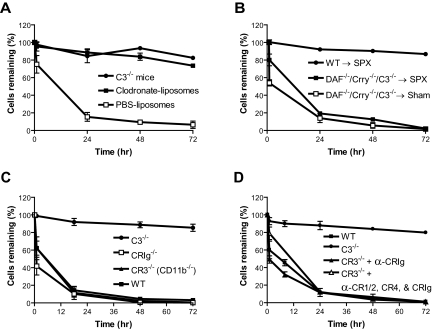Figure 5.
Role of macrophage and complement receptors in the elimination of DAF−/−/Crry−/−/C3−/− erythrocytes. (A) Treatment of recipient mice with clodronate-liposomes (■; n = 4) but not PBS-liposomes (□; n = 4, negative control) prevented accelerated elimination of DAF−/−/Crry−/−/C3−/− erythrocytes. C3−/− mice (●; n = 4) were used as control recipients. (B) Splenectomy (SPX) did not prevent DAF−/−/Crry−/−/C3−/− erythrocytes from accelerated elimination. DAF−/−/Crry−/−/C3−/− erythrocytes transfused into splenectomized WT recipients (■; n = 3) had similar half-life to those transfused into sham-operated WT mice (□; n = 3), and both were rapidly eliminated. WT erythrocytes transfused into splenectomized WT recipients (●; n = 3) remained stable. (C) DAF−/−/Crry−/−/C3−/− mouse erythrocytes were not rescued in CRIg−/− (□; n = 4) or CR3−/− (▴; n = 3) mice. WT (■; n = 3) and C3−/− (●; n = 3) mice were used as control recipients. (D) Neither blockade of CRIg by antibody (16G8.2) in CR3−/− mice (▴; n = 2) nor blockade of CRIg, CR1/2, CR4 by antibody (16G8.2), (7G6), and (N418) all in CR3−/− mice (▵; n = 3) did not rescue DAF−/−/Crry−/−/C3−/− erythrocytes. WT (■; n = 2) and C3−/− (●; n = 2) mice were used as control recipients. All error bars means represent (±SEM).

